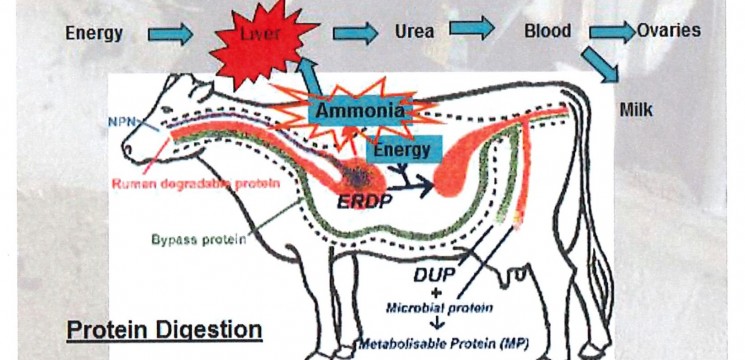News

Milk Urea (MU)
Most Dairy Companies have been giving their suppliers their herd bulk milk, Milk Urea (MU) figure for some time now. For the last few weeks MU has been available on fencepost for Fonterra suppliers.
Over the last few weeks many farmers have been asking me questions about their MU levels and how this affects their herd production and reproduction.
Understanding your urea levels can help optimise farm performance, by improving rumen efficiency - conversion of feed to milk and also reduce the impact on environmental nitrogen loading, reduce animal stress and possibly improve herd fertility.
So what goes on in the cow?
Protein is essential for healthy, productive animals.
Protein is estimated chemically by measuring the nitrogen and multiplied by 6.25 to give crude protein.
Crude protein is not true protein. True protein is made up of building blocks called amino acids.
When a cow consumes feed containing protein, if rumen bacteria cannot capture the ammonia and convert it to microbial protein, then the excess ammonia (a toxic molecule) enters the blood stream which is then converted to urea (a non-toxic molecule) by the liver and excreted by the kidneys. This process costs energy.
For grazing cows conversion of pasture protein can be very inefficient, grass crude protein can contain high levels of NPN (non protein nitrogen) especially fast growing nitrogen boosted grass. Problems occur if there is also a lack of sunlight. Grasses lack starch and the sugar content is not consistent.
There are a number of factors that will influence MU levels these include genetics, rumen turnover, rumen health, liver function, dry matter intake, cow condition, water intake, use of body tissue as an energy source etc.
There is no golden rule of where your MU levels should be, it’s very much farm individual.
If the MU values are high, your herd could possibly be wasting feed protein in their diet therefore forcing them to use energy to convert ammonia to urea through the liver.
If the MU values are low then this could impact on production due to the reduced microbial protein synthesis.
The key factor is providing adequate rumen available carbohydrate to provide the energy for the rumen microbes to convert ammonia into microbial protein.
So what should my Milk Urea (MU) values be?
The ideal range seems to be between 20 and 35mg/dl, levels below 20mg/dl could indicate excess carbohydrates in the feed or a shortage of protein or a bit of both.
Levels over 40mg/dl could be an indication of excess protein and a shortage of energy. It is at these higher levels that we see a greater impact on productivity losses.
Other recent news
10 February 2020
2.2ms/cow feeding 2.5kg pke 1.5 kg ddg 0.7kg grain summer calving of 36 cows has gone very smooth only got 2 left to calve. at 11.5 % MTs in spring calvers 8 week mating. will have to...
Read Post
